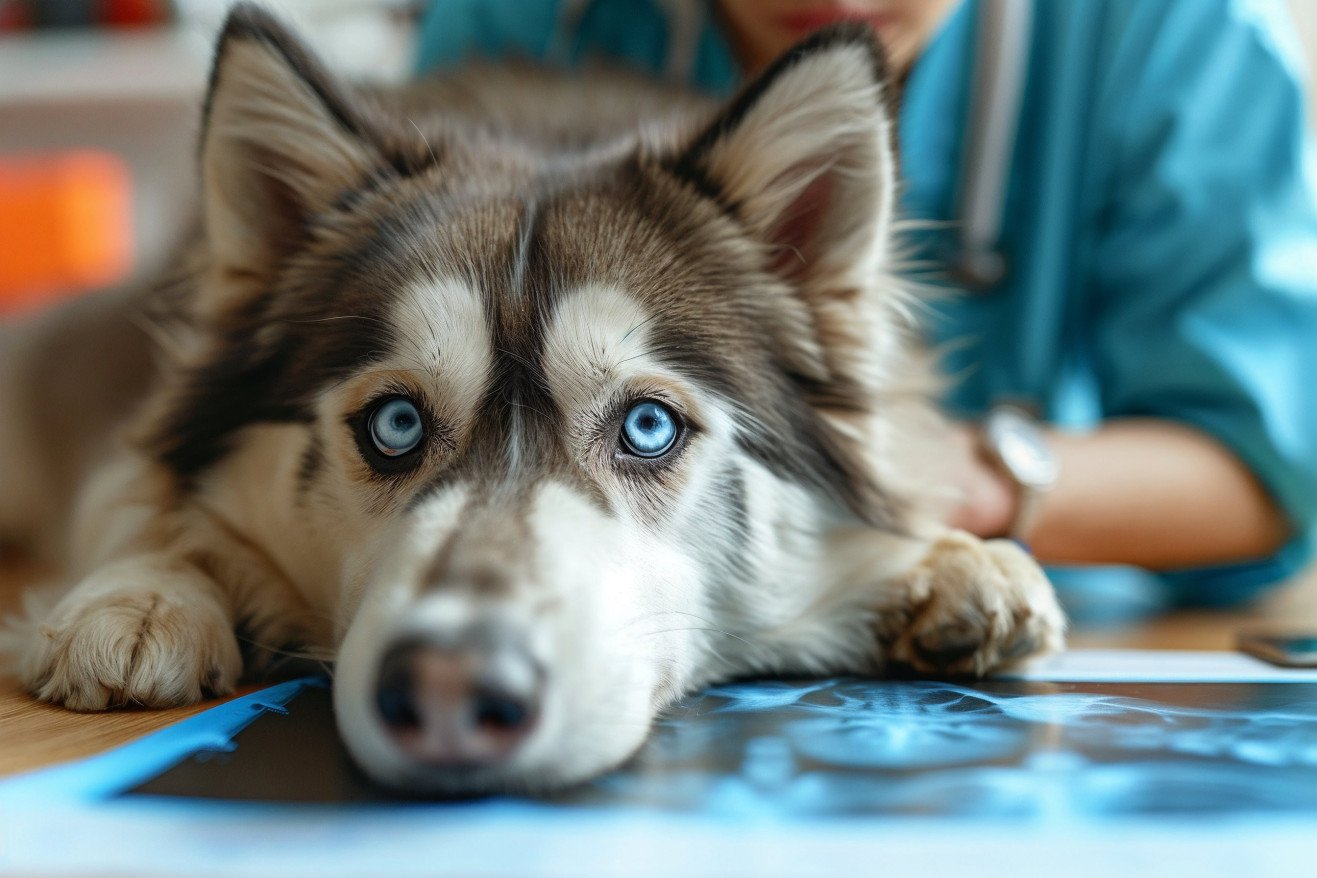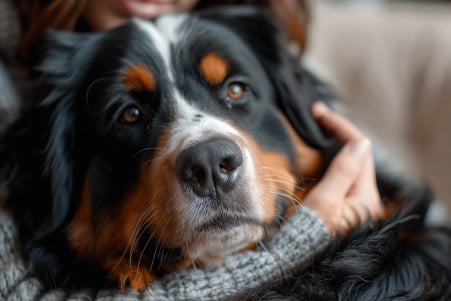Dog Intestinal Blockage Timeline: From Onset to Recovery
2 February 2024

If your dog is suddenly lethargic, it could be a sign of intestinal blockage. The timeline for a dog’s intestinal blockage starts with initial symptoms like vomiting and pain, moves to a diagnosis via physical and imaging exams, and often leads to an emergency surgery. After surgery, dogs typically take a few days to a few weeks to recover, depending on the severity of the blockage and any complications like infection or necrosis.
This in-depth analysis draws on a range of veterinary research and expert articles to outline the stages of canine intestinal blockage from start to finish. We’ll delve into the initial symptoms, the latest diagnostic techniques, treatment options, and recovery times. This information is important for dog owners to know as it can help guide next steps and aftercare, which can help ensure a dog’s quick recovery from this condition.
What are the most common initial symptoms indicating a potential intestinal blockage in dogs?
Knowing the Signs: The First Step to Preventing Intestinal Blockages
In order to protect the health of our furry friends, it is important to know the signs of an intestinal blockage. According to Spring House Animal Hospital, these signs include chronic vomiting, a sudden loss of appetite, signs of abdominal pain, and lethargy. These symptoms can become severe quickly, so it is important to know the signs so that you can catch them early and ensure a better outcome.
Pet parents, who know their pets better than anyone else, are key to catching these signs early.
A pet parent may be the first to suspect a blockage if they notice a change in their pet’s behavior, like a lack of energy or different whining.
According to Frontier Pet, this is when it becomes important to seek out veterinary care immediately. Not only will this help your pet feel better faster, but it will also increase the chances of a full recovery.
Untangling the Problem: Canine Intestinal Blockage Diagnosis
Once the initial symptoms of an intestinal blockage have been recognized, veterinarians turn to sophisticated diagnostic tools to confirm the presence and location of the blockage. Imaging studies, including abdominal radiography and computed tomography (CT) scans, are key to this process. A study on PubMed found that experienced radiologists rated both CT scans and radiographs as highly sensitive and specific, with CT scans being more sensitive in the detection of mechanical intestinal obstructions.
Advances in diagnostic imaging have also improved the speed and accuracy of diagnosis, which is important for ensuring that surgery can be performed as soon as possible. A study published in PLoS One demonstrated the value of CT scans in diagnosing gastrointestinal obstructions in dogs and in planning surgery. The accuracy of CT scans makes it easier to move quickly from diagnosis to the next critical phase of treatment.
The importance of accurate diagnosis for successful treatment is further supported by more recent studies that have shown the importance of timely and accurate diagnosis. A study on PMC of the perioperative outcomes of emergency abdominal surgeries also showed the importance of timely care. With the help of advanced diagnostics, veterinarians can make sure that they can quickly and accurately treat their patients, leading to the best possible outcomes for our furry friends.
From Intervention to Recovery: What to Expect
If a veterinarian has diagnosed a case of intestinal obstruction, the next step is to intervene with treatment. In many cases, surgeons will find that it is necessary to operate in order to remove the obstruction and prevent further complications.
While the Merck Veterinary Manual explains that some obstructions can be treated conservatively with methods like intravenous fluids, this is typically only true for incomplete obstructions. In general, procedures like endoscopy are used to remove foreign bodies from the stomach, while exploratory laparotomy is used for more severe obstructions.
The decision of how to proceed with treatment is based on the severity and location of the obstruction, with surgery being more likely if the object isn’t moving or if the patient’s condition is deteriorating. The American Kennel Club explains that complicated obstructions, especially those involving linear foreign bodies like string or rope, are more likely to cause the intestines to bunch up and require surgical intervention.
Following surgery, the patient will be closely monitored for immediate postoperative complications, including infection and dehiscence, which the Merck Veterinary Manual explains can occur 3–5 days post-operatively. Ultimately, the patient’s outcome will depend on the speed and accuracy of the veterinary team’s intervention after the diagnosis and the quality of their follow-up care.
The Path to Healing: Post-Operative Care After Surgery for Canine Intestinal Blockage
The path to recovery for a dog who has undergone surgery for an intestinal blockage is one that requires a lot of post-operative care. A 35% incidence of postoperative complications is reported in Veterinary Surgery, which means that it is important to keep a close eye on your dog after surgery. The veterinary team will work to keep your dog comfortable, prevent infection, and help the dog’s digestive system return to normal.
The recovery time can be very different for different dogs, and it can depend on a number of factors including the dog’s overall health and whether or not there are complications like septic peritonitis, as a study in PMC points out.
Some dogs will recover in a matter of days, while others may take weeks, especially if they have experienced severe complications like septic peritonitis, which can lead to longer hospital stays and more time in the ICU.
Most dogs will have a good long-term outcome after surgery for an intestinal blockage.
After surgery for an intestinal intussusceptions, most dogs will go back to their normal, happy selves, as shown in a study that included 153 dogs in Veterinary Surgery.
However, a small percentage of dogs will have a recurrence or a severe postoperative event, which is why it is so important to catch the condition early, as it can affect not only the dog’s survival but also their quality of life after surgery. With good care and monitoring, most dogs will be able to make a full recovery and go back to their normal, happy lives.
Preventing Intestinal Blockages in Dogs
Intestinal blockages in dogs are often caused by the ingestion of non-digestible objects like toys, socks, or bones. According to a study in Animals Basel, some of the most common items that dogs swallow and cause blockages include children’s toys, coins, and clothing.
In addition, dogs that eat large amounts of food or are fed a high-fat diet may be more likely to experience gastrointestinal problems like gastric dilatation-volvulus and pancreatitis, which can lead to blockages. A study on PubMed found that large meal size is a significant risk factor for these issues.
Pet parents can help prevent blockages by keeping a close eye on their dogs’ surroundings, removing any objects that could be swallowed, and controlling their diets by feeding them portion-controlled meals.
New insights into etiology from the Journal of Veterinary Internal Medicine recommend that pet parents focus on maintaining a balanced fat intake and avoiding high-fat foods. In addition, feeding dogs smaller, more frequent meals instead of one large meal can help reduce the risk, according to a study on PubMed.
These measures can help pet parents reduce the likelihood of blockages and support their dogs’ long-term well-being. By taking these steps, pet parents can build a stronger defense against these emergencies and help ensure their dogs live long, healthy, and blockage-free lives.
Following the Recovery Road: A Timeline of Canine Intestinal Obstruction
From the first signs of trouble to the happy return of tail wags, knowing the timeline of intestinal obstruction is essential for managing your dog’s health.
We’ve followed the timeline from the first signs—vomiting, loss of appetite, and abdominal pain—to the important role that pet owners play in recognizing these early symptoms.
Early recognition by pet owners and veterinarians leads to a prompt diagnosis, with the help of advanced imaging that makes intervention possible. While the surgical interventions are scary, they also offer hope, and the careful post-operative care provided by the veterinary team ensures a successful recovery.
While the recovery road may be bumpy, the watchful eyes of pet owners, the expertise of veterinarians, and the resilience of our furry friends all work together to get past this health obstacle. With a full understanding of how to prevent this condition, the chances of a dog developing an intestinal obstruction can be greatly reduced.
In the end, every step of the way matters—from recognizing the symptoms to the end of the recovery process and beyond. As a pet owner, your vigilance and quick action will help protect your dog and ensure they live a long, healthy life.


